the art of persuasion- art history
1/18
There's no tags or description
Looks like no tags are added yet.
Name | Mastery | Learn | Test | Matching | Spaced |
|---|
No study sessions yet.
19 Terms

century/movement; artist, where, this time marks what, where was this found in the church, what does this artist do with text, what saint is this showing, what term is this associated with this and what are they searching for, why is this place desirable to visit, who is in the center and what does he have around his head and body, right and left side? who are in the corners, who is beside christ, RIGHT SIDE- people doing what, helped by who, what is the building, the people beside Jesus are waiting for what, people wearing bags showed what, LEFT SIDE- references what term, was the do what to the people who saw it, people rising from where by what, the first sin represented by what, second and third represented by what, what construction is shown/building, it is modified how and to show what, references what ancient time, nobody is what
Middle Ages/Last Judgement Imagery; Gislebertus, West Portal of Cathedral of Saint-Lazare, Autun, France, Middle Ages marks the rise in christianity, this artist signs his name and has text, this was found in the Main entryway, Saint-Lazare=Saint Lazarus, pilgrimage to see holy relics (a physical piece that represents holy person from christianity with special powers), saint Lazarus has highly desirable relics- Lazarus’ bones, christ in the center- as the judge w/ a cross inscribed halo and a mandorla (only him and God have them), right side are the blessed (left=damned), trumpeting angels (4) in the corners, Mary is very close to christ, RIGHT SIDE- people are rising from their graves to be judged and being helped by the angels, there is a piece of a building showing the heavens, people beside Jesus are waiting to get into heaven, people wore a badge to show where they were going- one of the pilgrims was heading to Spain bc of his shell and the other with the cross is heading to Jerusalem, LEFT SIDE- was to scare you, people rising from graves being helped by demons, the sin of lust is represented- with the woman having snakes on her breasts, the sin of avarice(greed)- guy sifting through treasure and guy with money bag, many demons that are scary, another round-arch construction building which represents hell, modified to suggest it is a house of horrors by the demons yanking people, shows a scale to represent ancient Egypt’s weighing of souls, nobody is happy
pilgrimage
a (religious) journey, as a means of discovering more about christianity (visit very important locations associated with christianity)
mandorla
christ is traditionally surrounded by this- it is a means of asserting a divine glow around the entirety of Christ (shows he eminates light)
7 deadly sins
sloth, wrath, greed (avarice), gluttony, pride, envy, laziness
persuasion
you need to be good: need to make good choices or there are extreme and terrifying consequences
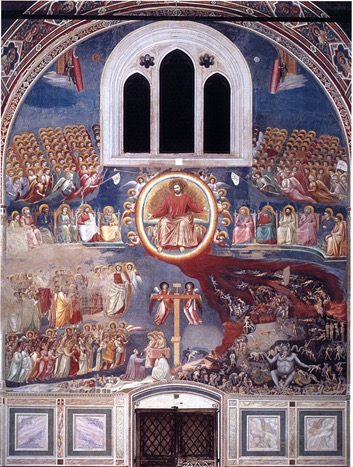
century/movement, artist, place and location, commissioned by who (name), what did he do, what was this building for, how big is it, who is in the center in what, what does he have around him, who is near him, right and left?, what did this man do and what about his father?, what did he do about it, RIGHT SIDE is more what, distinct representation of what, more of who, everyone is physically what, LEFT SIDE is what, dark and on a what, what is descending down and who is there, what is he doing, who is included, 1 man was what, the other man’s profession, many people are being what
Middle Ages/Last Judgment Imagery, Giotto, Arena Chapel, Padua, Italy, commissioned by a wealthy Italian merchant and banker, Enrico Scrovegni, private chapel for family, the last judgment scene takes up the entire wall, christ in the center- hierarchical scale, has a cruciform halo, surrounded by a mandorla, trumpeting angles surrounding christ, blessed on the right, damned on the left, userer/usury- charging high interest on loans (taking advantage of those who are needing assistance), Enrico’s father was specifically mentioned for usury and said to be in hell, vows to a better life to save his soul- Enrico is offering his chapel to the Virgin Mary, RIGHT SIDE; a lot more ordered, distinct heaven represented by a staircase, more angels at the top, rolling the sky to reveal vast golden gates, everyone is patiently waiting, LEFT SIDE; torturous, compartmentalized but still a dark cavernous location, shows a rocky mountain, tongues of fire descending down, massive demon w/ horns, throne made of spiky demons and he is eating souls, people hanging and disemboweled, bishop included w/ rosary beads, many being tortured
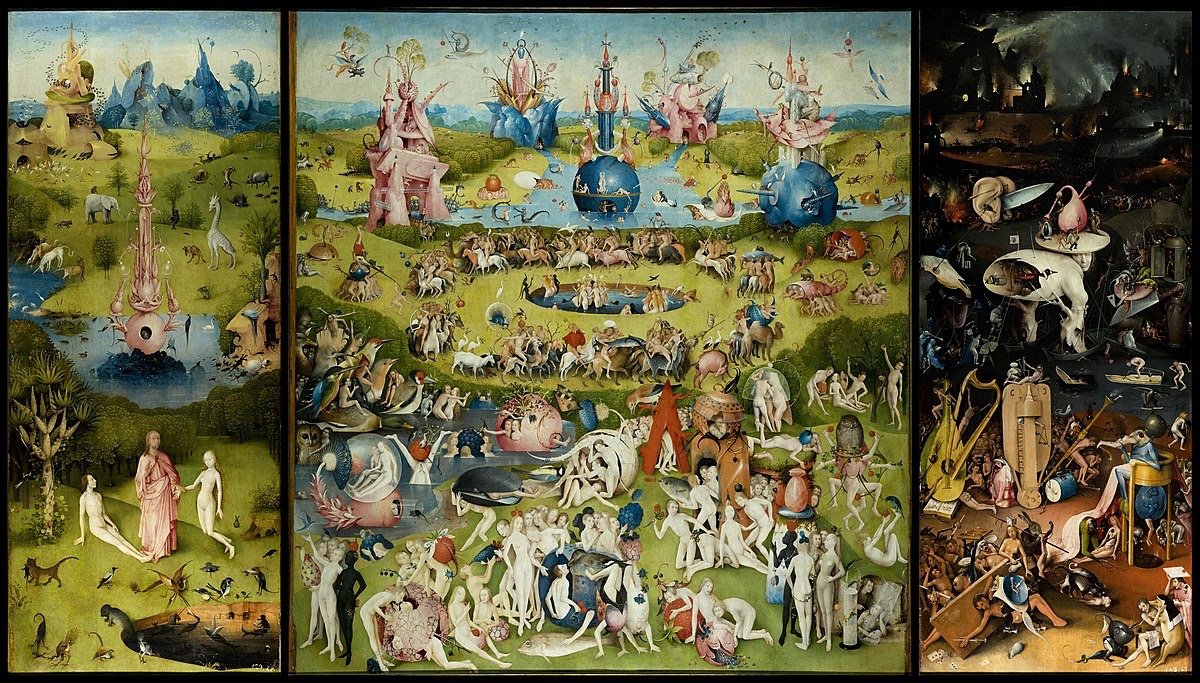
century/time period, artist, name, what was his view, he was very what, speaks to what, is a what which is what, LEFT PANEL; what view and who is in it, what is the center piece and what does it mean, what is the pit and what does it foreshadow, CENTRAL PANEL; who is this, shows what and what names, what shows temptation and overindulgence, man eaten strawberry shows what, nudity shows what, what does this artist want to show?, there are many plants that are what shown throughout, no one is working which shows what, houses over the top shows what, showiness shows what, bird inhumanly portrayed too show the what world and how animals do what better than humans?, RIGHT PANEL; this is what place, what is happening to the people, they are being tortured by what, cracked egg= what, ear and knife= what, there are people being crucified by their what
Last Judgement/Renaissance (1500), Hieronymus Bosch, The Garden of Earthly Delights, highly pessimistic view (humans sinful), inventive artist of his time- imagination and fantasy, speaks to excess and the consequences of excess behavior, triptych- has portrayed it in the manner of a religious altarpiece, LEFT PANEL; 1) panoramic view of the Garden of Eden, God introducing eve to Adam but they aren’t the central piece, the pink fountain is enticing and covered with thorns but very beautiful and elaborate- shows there are consequences to bad behavior, the black pit is foreshadowing the consequences of eating from the tree of knowledge of good and evil, fantastic and imagined features- animals killing themselves (foreshadowing), CENTRAL PANEL; descendants of Adam and Eve, humanity gone wild, almost all of the 7 deadly sins is represented except wrath, everyone is nude and frolicking, lots of fruits that represent temptation and overindulgence of sinful behavior, avarice/greed or gluttony in the man who is eating the strawberry, lust is represented in the nudity, wants to show that everyone is susceptible to sinful behavior, thorns throughout, shows sloth because no-one is working, even the houses are over the top- speaks of pride, the desire for showiness speaks to vanity, bird inhumanly portrayed, the topsy turvy world, animals (birds) behave better than humans, RIGHT PANEL; dark cavernous place in hell, the people are tortured by the things that brought them pleasure in life, cracked egg person is bosh, tavern inside of his body shows gluttony, weird ear and knife tank- associated with gossip- slowly crushing people under the knife, people crucified on the musical instruments
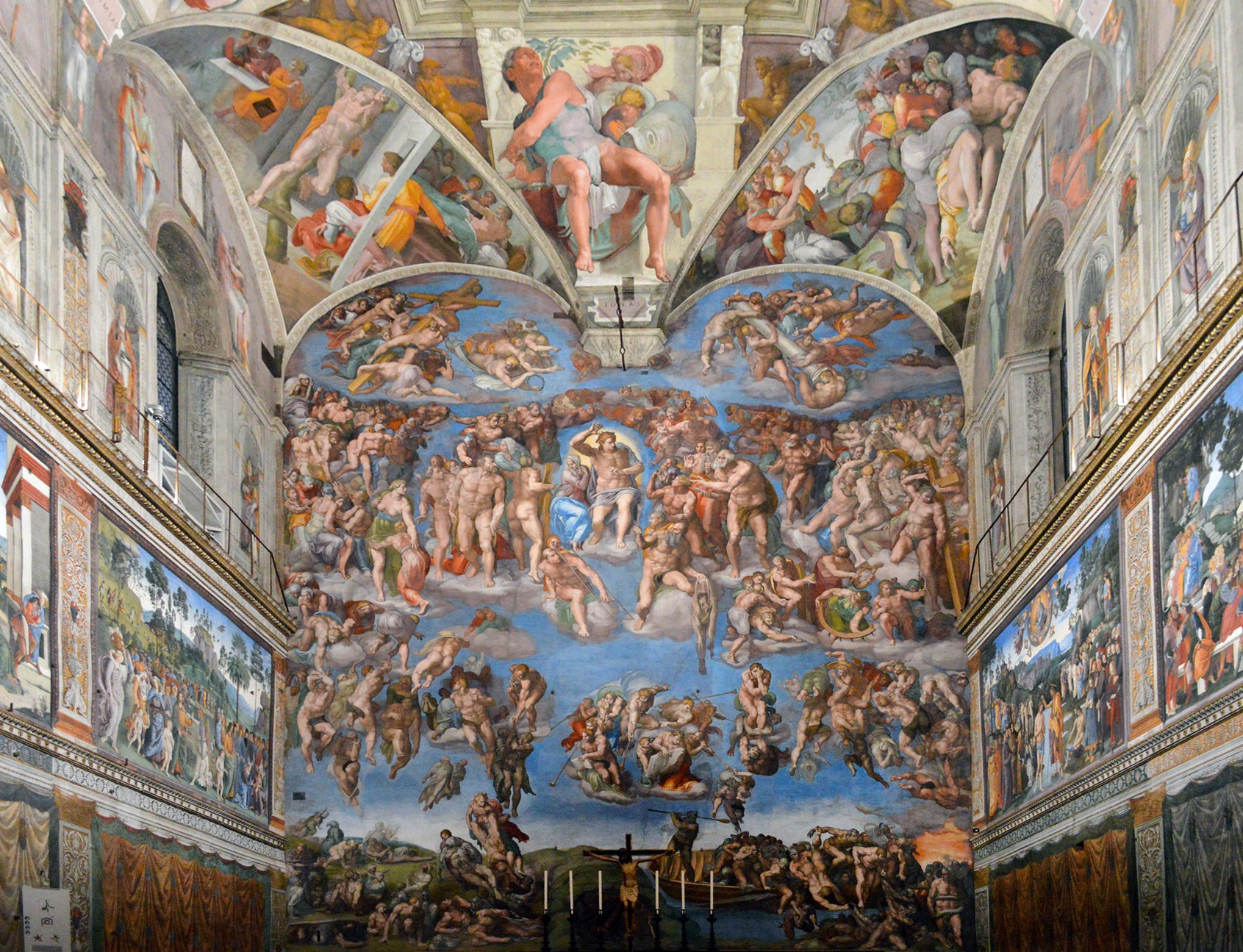
time period/movement, artist, where, for who, painted what before and came back for what, in the painting who is in the center and what does he have, how is this different from other representations of christ, who is beside christ, right and left, trumpeting angles were different because of what, why? who else can we see here, what did people of the time think about nudity? how was it fixed, the damned side line was where, what is happening here, where is the mouth of hell, what was painted about hell- name, what two people were there and what did they do, how many levels of hell and what were included in some of the levels, what level was shown here an who was the character portrayed as, who had the knife and skin in heaven? where was Michelangelo, what two ways could Michelangelo have used to make his self-portrait make sense in the place he put it
renaissance/last judgement, Michelangelo, Sistine Chapel, Vatican, this is the pope’s private chapel, painted the ceiling early in life and the back wall later in life, Christ with a mandorla, not in hierarchical scale so it doesn’t stand out as much, but is still monumental bc christ is muscular and his form is pronounced, Mary is on the right side of christ, blessed on the right, damned on the left, trumpeting angels lacked clarity because they have no halos or wings- he didn’t want to disfigure human form, many recognizable forms through attributes they hold- fist full of arrows (st. Sebastian), John the Baptist, people thought the nudity was inappropriate bc these figures are heavenly and after he painted it, another person came in and covered the heavenly with small cloths, the damned side is underneath where the angels are beating the people back down, the mouth of hell is right behind the altar (pope didn’t care-people did), Michelangelo knew about greek gods and he painted Dante’s inferno (the divine comedy)-speaks of a journey Dante takes through hell, purgatory, and heaven; two characters mentioned were Charon- who ferries the damn across the river and into hell for judgement (puts an emphasize on mental torture not physical) and Minos- who is the judge in hell and decides which level the people will spend eternity (9 levels) many of the 7 deadly sins included, his tail wrapped around his body the amount of times to show which level the people would go, level 2 is lust and Michelangelo showed level 2 here, the harsh critic (priest) was a self-portrait of minos, he has donkey ears to show he was an ass, included a self portrait of himself, a knife and some skin (st. Bartholomew skinned alive)- inside the skin is Michelangelo’s face- it is said that he was heavily criticized and this is why he out himself inside of the skin bc he felt like that, the skin is also representative of how he is uncertain of where he will be - he is in the heavens but is hanging over the side of the damned
17th Century- The Counter-Reformation (renewal of the catholic church after Martin Luther broke away), what was it supposed to do, five rules- Pronouncements on Art explain
was supposed to fix religious portrayals, 1. subject had to be clear- should be no question as to what they were looking at, 2. should be accurate to human proportions and scale (render people the way they look), 3. artwork should sting the heart- generate a powerful emotional response to the view, 4. didactic- should teach you and educate you, 5. should be direct and engaging- should bring the viewer into the experience
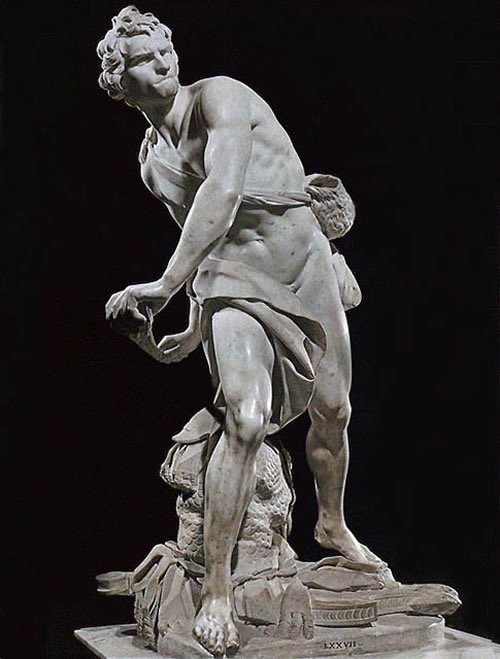
century/movement, artist, name, what did he do, how did this piece adhere to the pronouncements, 1. how- where is this in David’s story, what was shown that tells us who he is, 2. what about the pose and scale, 3. how does it generate emotion? 4. how was it didactic? 5. was it direct and engaging?
17th Century Counter-Reformation, Gianlorenzo Bernini, David, sculptor painter, architect, city planner, did he adhere to the pronouncements on art, 1. we can see who it is- David is fighting Goliath, he has stones, David played the harp and that was portrayed below him to soothe Saul and write the psalms, 2. pose and scale is believable, even the face looks believable- David is focused and scrunching up his face and he is pulling in his bottom lip, 3. it generates emotion if one is willing to engage and understand, 4. he also had the suit of armor that Saul gave him but he didn’t wear it because it didn’t fit but he also didn’t need it because he had the armor of God (which is how this was didactic),5. direct and engaging- placed directly opposite to the entry of the room, ready to fling a stone right at you, (charged space you occupy),
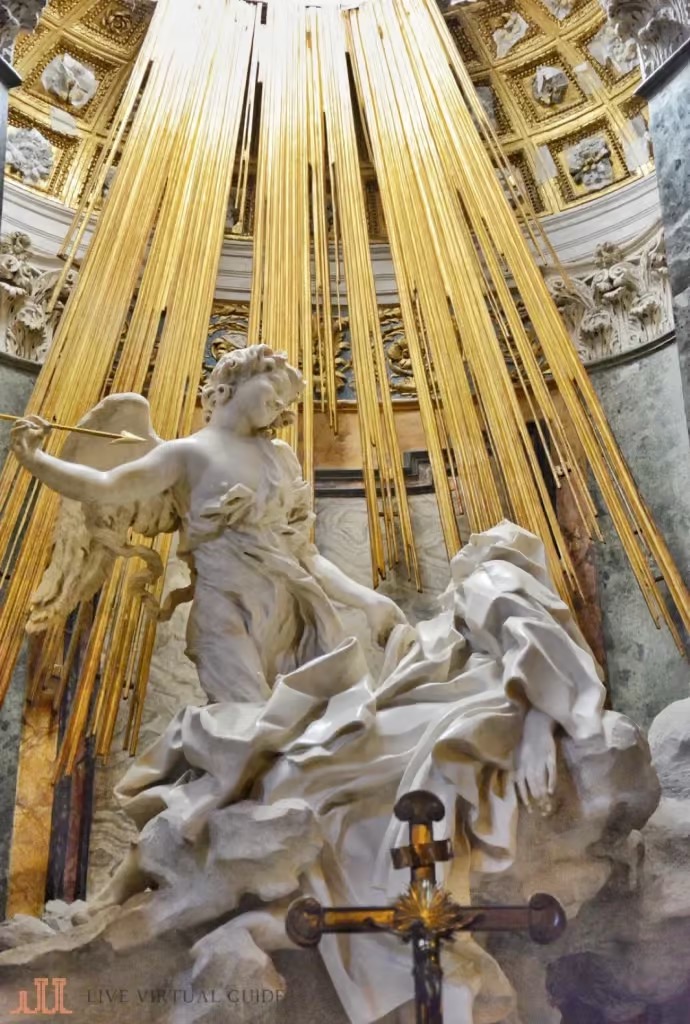
century/movement, artist, name, where from (place and country), who’s place was this and where are they in the sculptures, what do we see at the top and how did he do it, how are the light sources similar, what does that light source represent, how did he make the sculpture more alive (what did he add), what is inside of this, what are the rays behind made of and why are they so bright, what was st. Theresa known for, what happened in this one, how is the person shown, what about him and what about her and why,
17th century Counter-Reformation; Gianlorenzo Bernini, Ecstasy of St. Theresa, Cornaro Chapel, Santa Maria della Vittoria, Rome, Cornaro family’s private family chapel, the family occupies the theatre boxes on the side in portrait from, we see the top full of light with clouds and figures occupying the clouds, he put new plaster on in organic shapes and painted the clouds with shadows to make them look real, the light source on the top is the same one putting light on st. theresa (this light is the Holy Spirit), he constructed the frame of columns to make the place more alive, inside is St. Theresa and an angel, bronze rays behind them and covered in gold to create divine light, there is a window in the chapel to enhance that the light is divine (he covers it up but allows the natural light to come in), st. Theresa was said to have divine encounters, the figure pierced her but still had a sweet expiration giving her the power of God, he wears thin clothes that looks as thought it is moving bc it is to show the power of God, Theresa has thick heavy garments to show she is earth bound and her eyes are closed to show she is not seeing it with her eyes, her mouth is open to show she has already been pierced, the people on the side are very engaged in conversation about what is happening
illusionism
the painting is so believable it looks real; an illusion of reality
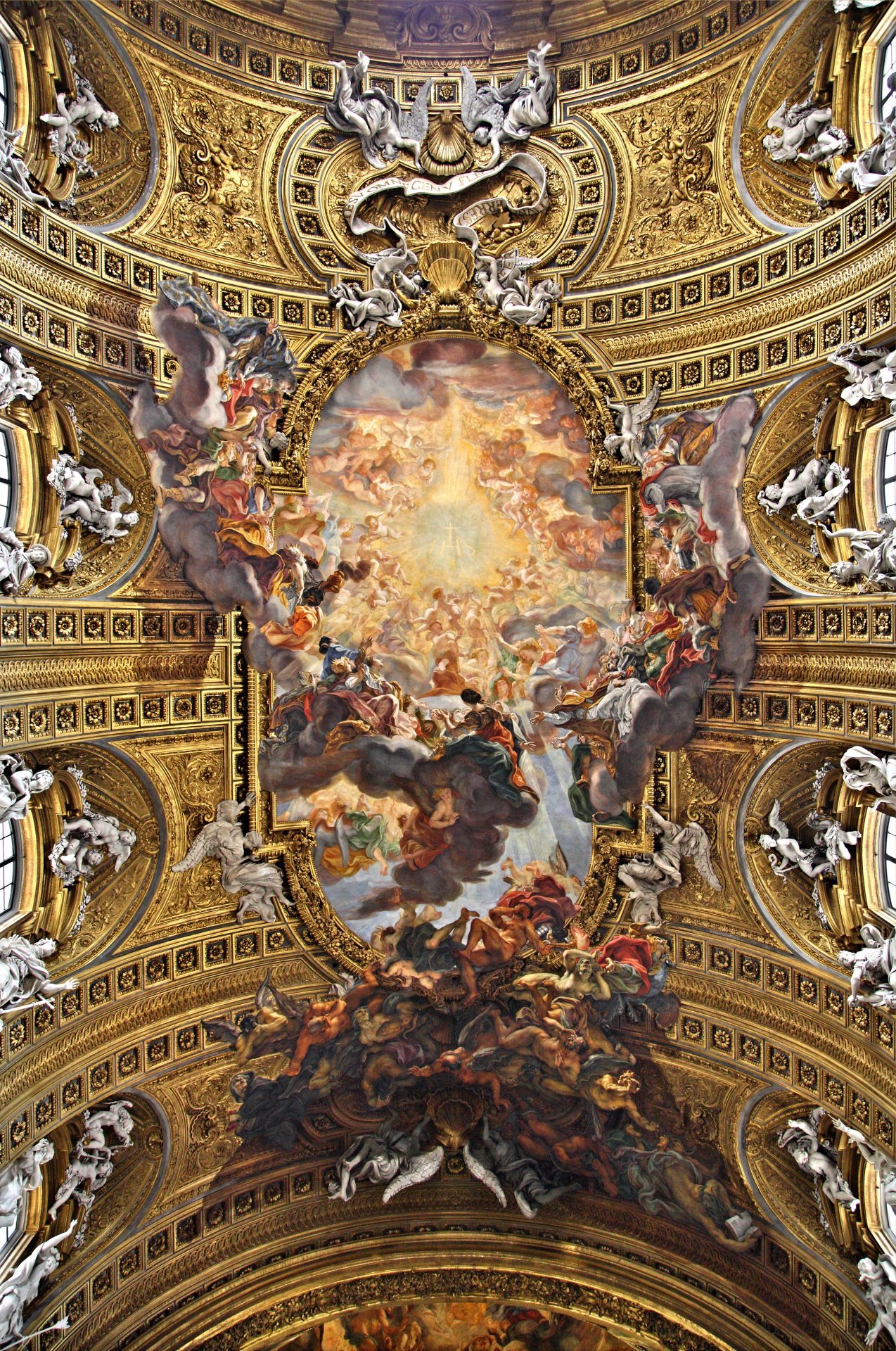
century/movement, artist, name, where was this found, what did the churches leaders do and what was their job, how did this artists create the shadows around this ceiling painting, what did this artist add to create this texture, what is the greek abbreviation for Jesus- how do we see this within the painting, what extends through the letters and what is the symbolic reference, why are the figures arranged in a semi-circle, who are the people around Jesus, who are the people below the clouds, who do they represent in heaven and hell, how do we know this is representing these people
17th century Counter reformation, Giovanni Battista Gaulli, Triumph of the Name of Jesus, Church of the II Gesu, Rome, the Gesu taught and were to promote the sovereignty of the church after the reformation, he uses plaster to make shadows, adjusts the perspective of the figures so they accurately look like we are looking at the people from below, built architecture around the ceiling to create texture and created the frame so that it would look like the figures are an extension of the outside world into the ceiling, the greek abbreviation of Jesus’ name is IHS and a cross extends up through the H, it is to show that the symbolic reference of christ is providing the light, the figures are arranged in a semi-circular manner and shows they are accepting the divine light that is generated by Christ, these are all the followers of Jesus, the sky illuminated a separation between the followers of Christ and then shows the people who broke away from the church, who are being cast out from heaven, we see demons and leathery wings showing these people are the damned
reformation
the split between catholics and protestants; lead by Luther
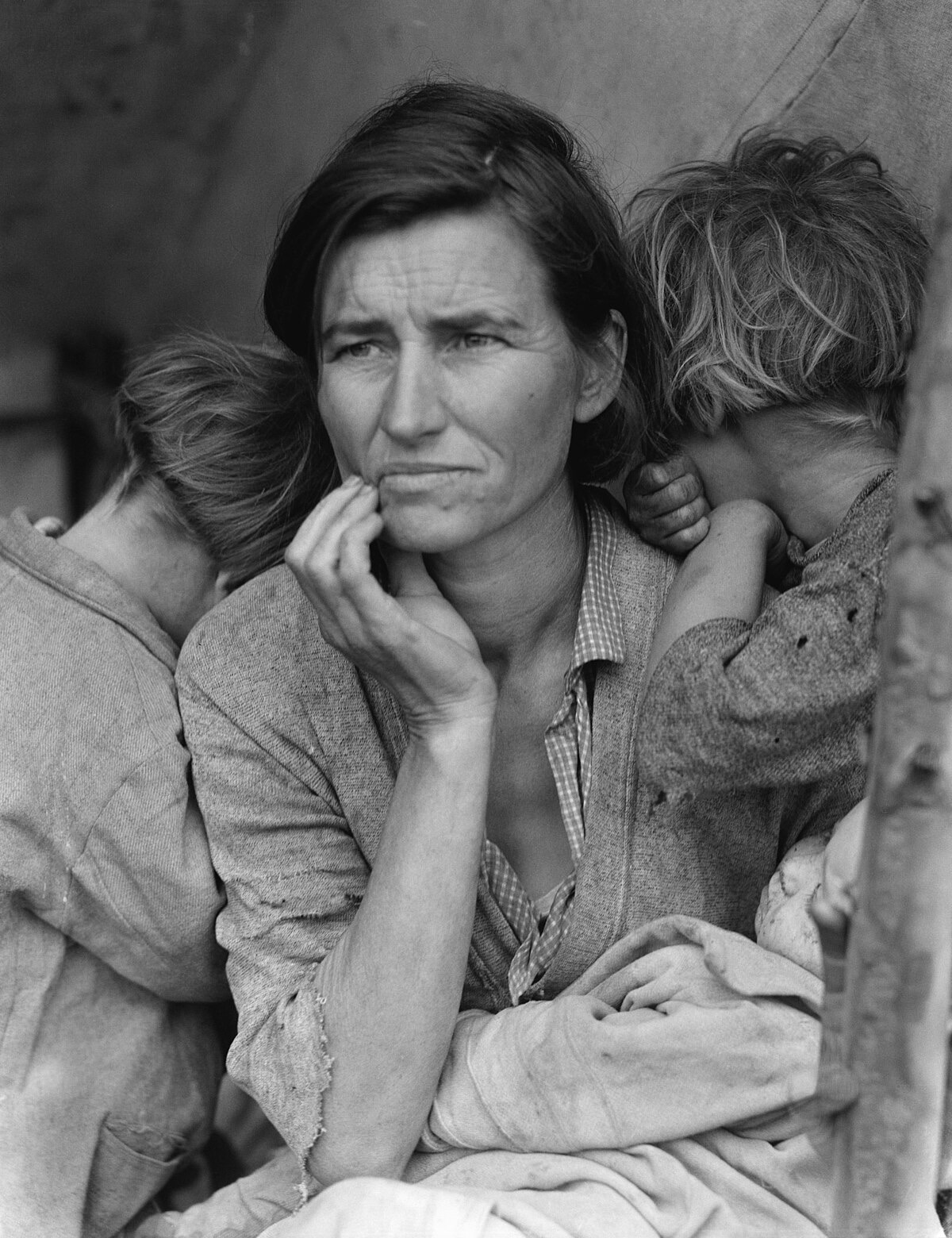
century/movement, artist, name, place, medium, what was her job, she was the first what, who hired her, what was her job an example of and what government agency did this, who did she focus on and why?, what did her job help to do for this population and what did it end up doing for the American people, this woman did not have a what, she has how many kids in the photo but how many in total, the kids leaning on the mother shows what, it also creates what shape, her face shows what, they have what and live where, they look what, this shows what about the American people, she zooms in to show what
20th century Great Depression, Dorothea Lange, Migrant Mother- Nipomo, California, medium is photography, recognized as the first documentary photographer, she was hired specifically by the farm security administration, she was to go to the rural areas of our country and document the conditions across the nation, her job was one of the many government relief efforts to (WPA- works progress administration that created jobs to help Americans), by focusing on the rural population she provided evidence to encourage public support to help the rural population, they not only helped to encourage others to help the rural population, but became an inspiration to draw on their strength, fortitude and perseverance to survive the GD, this woman was not named, 3 kids in the photo she has 7 kids, the kids leaning on her shows the family bond as a means of strength, this creates a triangular shape and creates stability, her face shows her uncertainty but she is still there as a strong figure, the wrinkles and the way her face is shown lets us know that she has worked and worried- she looks a lot older than she is (32), they have very little you can see through their clothes and are dirty, they live in a tent, this photo is representative of the American people to do what you can to survive for your children and yourself, she zooms in to show that this family is heroic
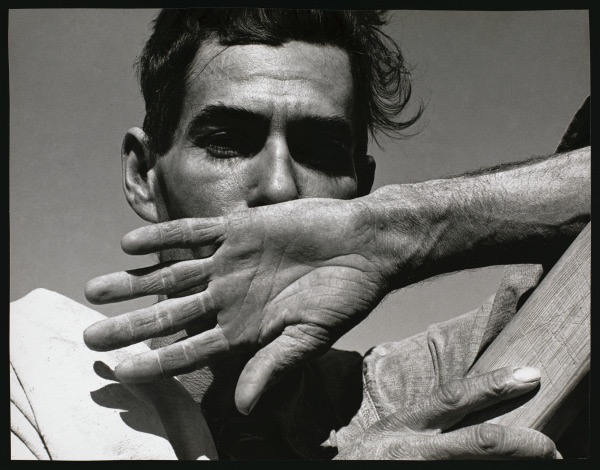
century/movement, artist, name, place, medium, what is this man doing, you can tell the heat through what, what do we notice about his face and hands, we can see what on the palm of his hands and we see no what, the emphasis on his forehead shows what, shows what main idea of the American people
20th Century Great Depression, Dorothea Lange, Migratory Cotton Picker, Eloy, Arizona, photograph, this man is on a break from difficult work, you can see the light illuminating him and know it is hot, we can see the tan on his face and hands from working hard in this hot sun, we can see scars- there are no gloves, he is more than just a laborer- he is an intelligent thinking being which is shown through the emphasis on his forehead, emphasizes the strength of the American people
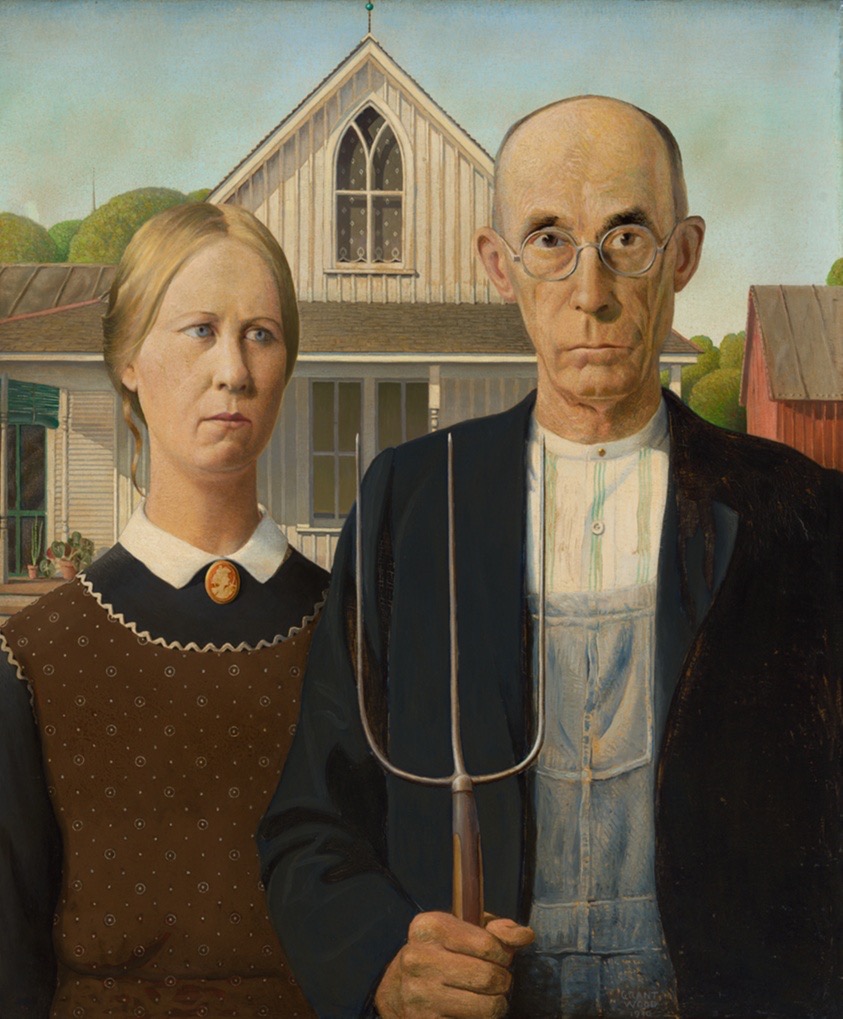
century/movement, artist, name, medium, what is she doing instead of leaving her family, this speaks to what idea, exhibited where, the American people described this using these 5 describing words, this represents what, this references our beginnings of what, they are both wearing what to show us about what they do, they provide for who, this image shows the celebration of family, their expressions show what, they dominate the picture plane because it shows they are protecting what, why American gothic? this speaks to what between them
20th Century Great Depression, Grant Wood, American Gothic, painting, sacrificing her own freedom to maintain her family home and help her father because her mother is gone, this speaks to the idea and commitment of family, this was exhibited in Chicago, these people show strength, dignity, fortitude, resoluteness and integrity, this represents what the American people are about, many saw references to our countries puritan beginnings in a good way through, both wearing simple clothes and because they are farmers they can provide what they need for themselves while also providing for others, this image shows the celebration of family, this is communicated through their expression- he is a fierce man and the head of the family, their straight upright nature as well as their domination of the picture plane- this shows they are protecting their home and their farm by covering the entirety of the picture plane, he has a pitchfork to use for his livelihood as well as his weapon, American gothic because the style of the house is known as carpenter gothic- a self taught frontier form of architecture built by individuals who had awareness of earlier European forms, this speaks to our country being founded by people coming to American for new lives (we brought with us knowledge and traditions from other cultures), this farmhouse has a pointed arch window- so this references the church in gothic times, this shows that their faith is a huge reason why they are okay during this time,
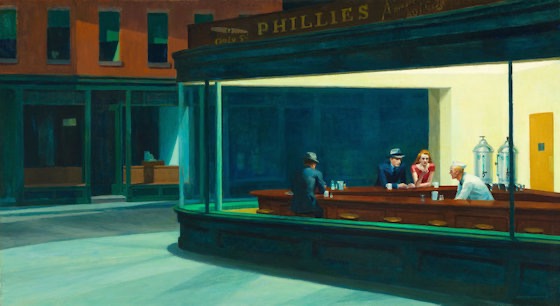
century/movement, artist, name, he paints both what, this shows the mentality of what during the GD, this isn’t mean to inspire it is supposed to capture what, the streets are stripped of what, what is not in this image, there is no way to do what, the men are both in suits
20th century/ Great Depression, Edward Hopper, Nighthawks, he paints urban America and is inspired by New York City- he also paints small town American, this one is the first, this image shows the American mentality during the depression, they aren’t meant to inspire, they are supposed to capture the overwhelming feeling of loss and loneliness during the great depression, stripped of life around the streets- it looks dead, there is nothing- no signs, cars, trash, just nothing, apartments with no life inside, no way in and no way out, mens suits show they are still looking for a job or are lucky and still have a job, their expressions show there is no life to them and shows the depression, the woman is holding a dollar- maybe her last- theme is no way out of this darkness and depression

century/mmovement, artist, name, the trees show what, same set up as what, what happens to the man here, theme is what, there is no what here, very what
20th Century Great Depression, Edward Hopper, Gas, the heavy thickness in the trees form a barrier of them being cut off from everything, the same set up as nighthawks- very empty, the man becomes like the vertical gas pump, he is disappearing with them because there is no-one to sell to and interact with, theme is loneliness, no signs no pop machines, no-one to serve, no hope, very depressing